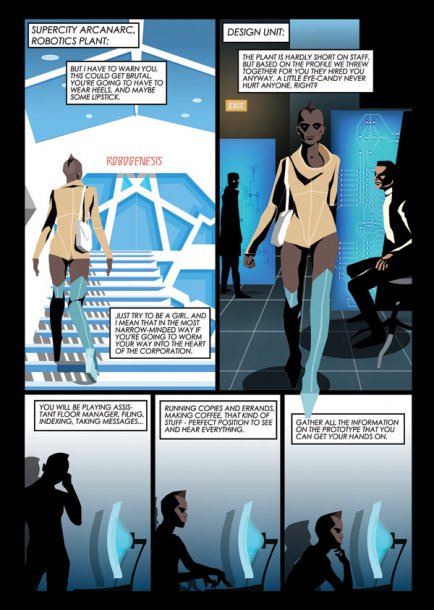"Ananiya the Revolutionist", de Milumbe Haimbe
Publicado28 Jan 2015

Milumbe Haimbe, artista nascida na Zâmbia em 1974, distinguida com o Prémio Blachère Foundation, é autora de Ananiya the Revolutionist, um trabalho que apresentou na Bienal D'art 2014. Ananiya, a heroína, é uma jovem negra de 17 anos que faz parte de um movimento de resistência à operação de uma mega empresa para a criação de um robô que corresponderia à "mulher perfeita". Entre a novela gráfica, a banda desenhada, a pintura e o design digital, este trabalho questiona as fronteiras de género e as formas narrativas e representacionais estabelecidas, abordando a questão dos modelos sociais femininos, em particular no contexto africano.
Haimbe digitally paints in 15 panels a dark and conformist dystopian world. There she deals with issues such as gender politics, representation and racism and in it Freja comes in only one model: she is caucasian, blonde, green-eyed, thin, with a perky set of breasts, a brazilian wax job and is branded with the conglomerate’s logo. In Ananiya’s near future the complex, varied and unpredictable human woman is deemed obsolete and slated to be culled.
When I spoke with Ugochukwu-Smooth C. Nzewi, a co-curator of the exhibition where the series was shown, he described the project as “a great woman narrative” that resonates on numerous levels, particularly in light of the dearth of black, female, and genderqueer heroes. He remarked “This is Africa saving the world. It’s like the classic case of ‘The Empire Writes Back’!”
Ananiya the Revoluntionist is an instance of art’s capacity to re-imagine identity. Like Nzewi, emerging artist Bogosi Sekhukhuni explains why a re-imagining of self, particularly within the paradigm of the hero can be powerful.
Representation of women including their exclusion in media is an ongoing issue around the globe. Narrow portrayals and omissions illustrate the proverbial pink elephant in the room: they are a barometer on whose voices apparently don’t matter within a society.
Looking at the Hollywood spectrum of things, the parity reality is grim. As of 2013 a survey on on-screen representations indicated that female roles only made up 15% of protagonists, 29% of major characters, and 30% of all speaking roles in the top 100 films of that year. Furthermore of those female characters, 14% were African American, 5% Latina, 3% Asian and 3% otherworldly, the majority of 74% were Caucasian.
Texto de Missla Libsekal completo, em Are There Superheroes That Look Like You?
